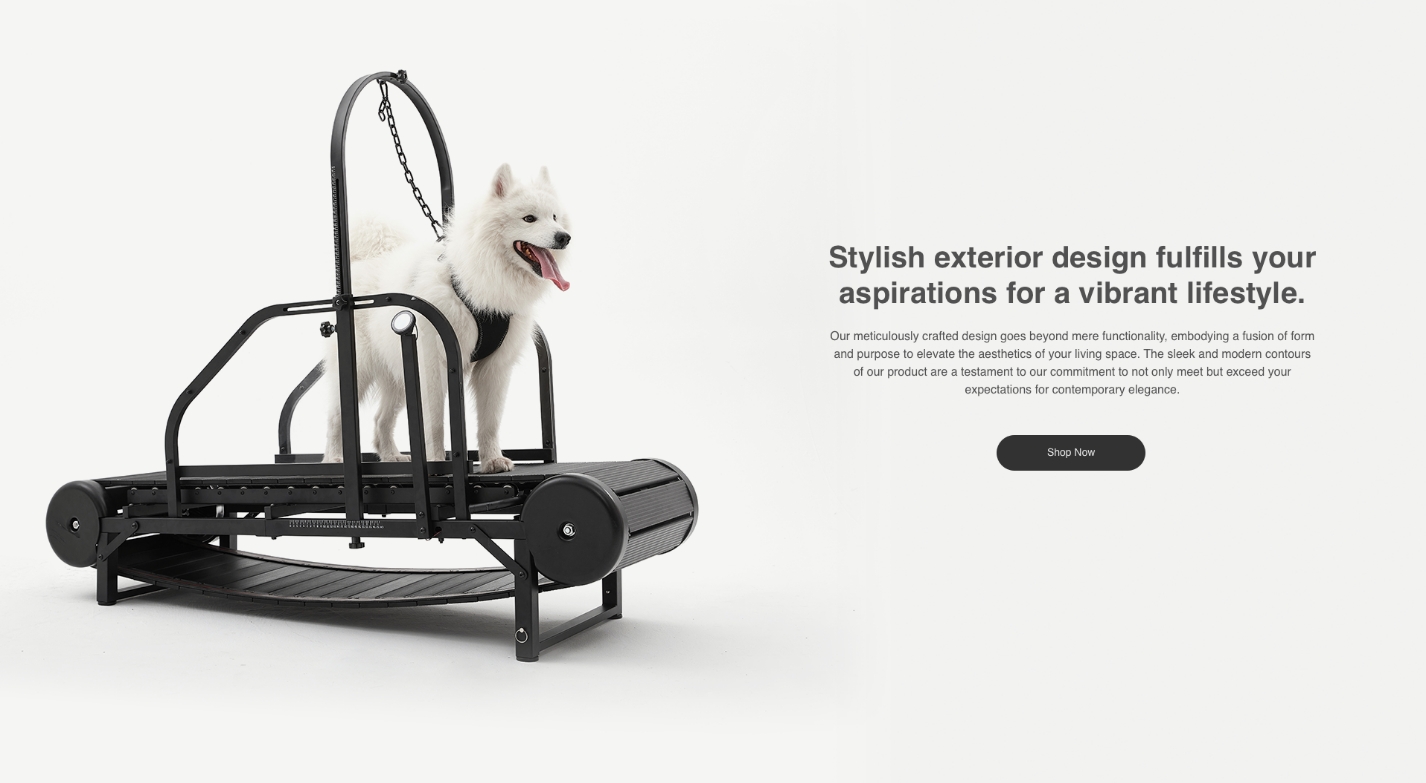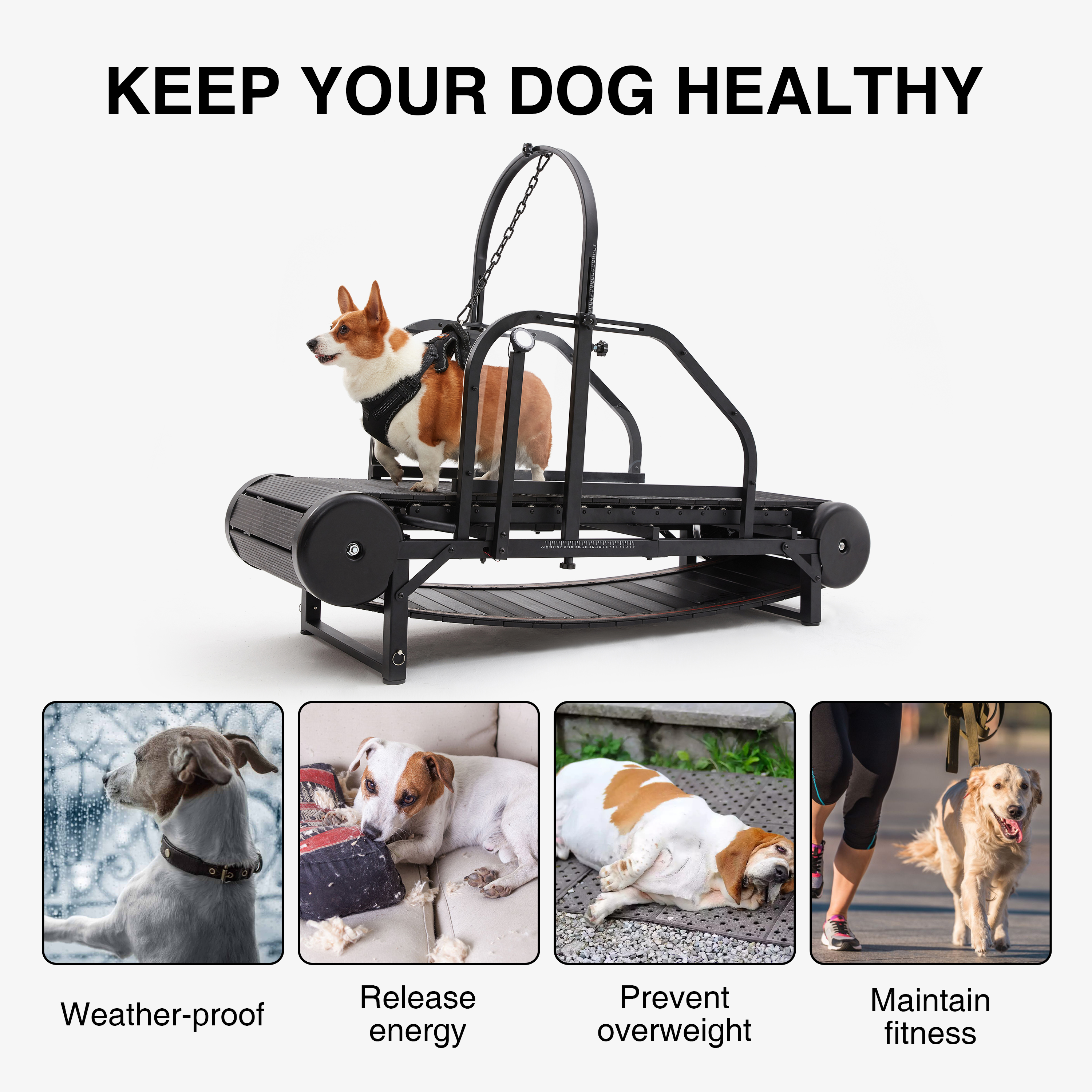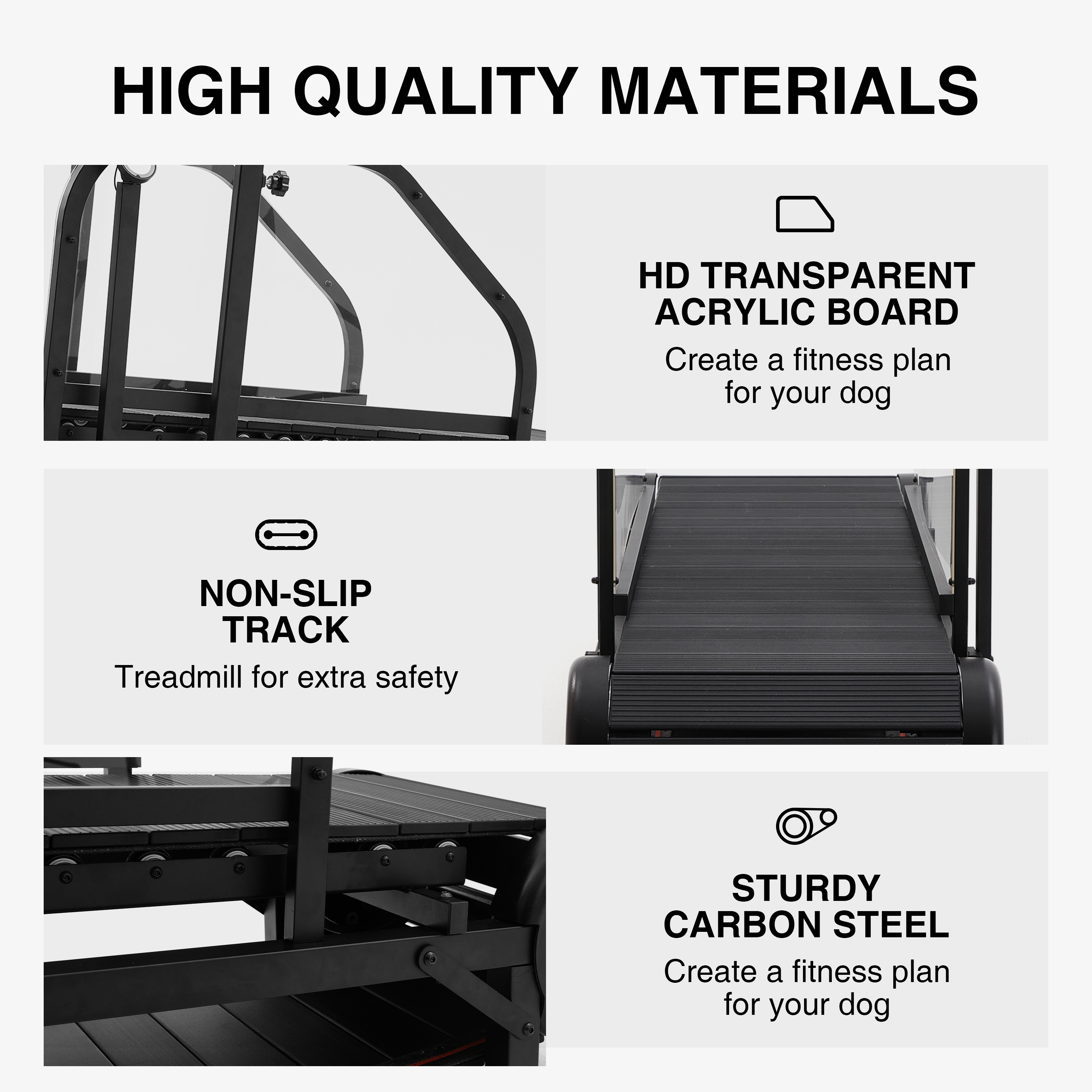The Best Dog Treadmills to Keep Your Pup Active

Keeping our furry friends active is essential for their health and happiness. I’ve seen firsthand how a dog treadmill can transform a pup's energy levels. With 54% of dogs facing obesity, finding ways to exercise indoors becomes crucial. A dog treadmill offers a fun and safe way for our pets to stay fit, especially when outdoor conditions aren't ideal. Plus, it allows us to ensure they get the exercise they need, even on busy days. Let’s explore the best options available to keep our pups moving!
Key Takeaways
Dog treadmills are essential for keeping pets active, especially for those facing obesity or during inclement weather.
When choosing a treadmill, consider your dog's size, weight capacity, speed, incline options, and safety features to ensure a good fit.
Look for treadmills with whisper-quiet motors to keep your dog comfortable and prevent anxiety during workouts.
Portability and storage options are important; choose a treadmill that is easy to move and store, especially in smaller living spaces.
Training your dog to use a treadmill should be gradual; start with familiarization, short sessions, and positive reinforcement to build confidence.
Regular treadmill exercise can help manage your dog's weight and improve overall health, making it a valuable addition to their routine.
Combine treadmill workouts with outdoor activities for a balanced exercise regimen that promotes both physical and mental stimulation.
Key Features to Consider When Choosing a Dog Treadmill

Choosing the right dog treadmill can feel overwhelming. I’ve learned that focusing on a few key features makes the decision easier. Here’s what I consider essential when buying a dog treadmill.
Size and Weight Capacity
First, think about your dog's size. Not all treadmills accommodate every breed. For instance, the GoPet PetRun PR725 Encloseable Treadmill offers a spacious running area of 71 inches long and supports dogs up to 176 pounds. This feature is crucial for larger breeds that need room to stretch their legs. On the other hand, if you have a smaller dog, the dogPACER MiniPACER Treadmill is designed for dogs up to 55 pounds. It’s compact yet sturdy, perfect for smaller spaces.
Speed and Incline Options
Next, consider speed and incline options. Different dogs have different exercise needs. The dogPACER LF 3.1 Treadmill provides a maximum speed of 7.5 MPH, which suits most dogs. If you want to challenge your pup, look for treadmills with adjustable inclines. The Shelandy Smart Pet Treadmill allows you to set the incline between 5 to 9 degrees, giving your dog a more intense workout. This flexibility helps keep your dog engaged and fit.
Safety Features
Safety should always come first. I appreciate treadmills that include safety features like automatic shut-off systems. The Shelandy Smart Pet Treadmill has an automatic switch-off that activates after 30 minutes of use. This feature ensures your dog stays safe during workouts. Additionally, look for treadmills with quiet motors. A whisper-quiet motor, like the one in the dogPACER LF 3.1, helps prevent startling your pup while they exercise.
By keeping these key features in mind, you can find the perfect treadmill for your furry friend. Each dog has unique needs, so take the time to choose wisely.
Noise Level
When I first started using a dog treadmill, I worried about how noisy it might be. After all, I didn’t want to scare my pup or disturb the neighbors. Thankfully, many modern treadmills come equipped with whisper-quiet motors. For instance, the dogPACER LF 3.1 Treadmill operates quietly, allowing my dog to focus on running without distractions. This feature is especially important for anxious dogs who might get startled by loud noises.
I recommend checking the noise level before making a purchase. A quieter treadmill can make a big difference in your dog's comfort and willingness to use it. If you have a sensitive pup, look for models specifically designed to minimize sound.
Portability and Storage
Portability is another crucial factor I consider when choosing a dog treadmill. I love being able to move the treadmill around my home easily. Some models, like the dogPACER MiniPACER Treadmill, are lightweight and compact, making them perfect for smaller spaces. I can easily tuck it away when not in use, which helps keep my living area clutter-free.
If you have limited space, look for treadmills with folding designs. The dogPACER LF 3.1 Treadmill features patented folding technology, allowing me to store it conveniently. This treadmill folds up neatly, making it easy to slide under a bed or into a closet.
Top Dog Treadmills Reviewed

Best Overall Dog Treadmill
dogPACER LF 3.1 Treadmill
When I think of the best dog treadmill, the dogPACER LF 3.1 Treadmill immediately comes to mind. This treadmill offers a spacious running area of 71 inches long and 16.5 inches wide, making it suitable for dogs of various sizes. It supports dogs weighing up to 179 pounds, which is impressive. I love how it features a whisper-quiet motor, allowing my pup to run without distractions. The patented folding technology makes storage a breeze, too.
Pros and Cons
Pros:
Spacious running area
Supports larger dogs
Whisper-quiet operation
Easy to store
Cons:
Might be too large for small spaces
User Experiences
Many users rave about the dogPACER LF 3.1. One owner shared, “My dog loves it! He runs every day, and I can see his energy levels improving.” Another mentioned, “It’s easy to fold and store, which is a huge plus for my small apartment.” Overall, this treadmill seems to be a hit among dog owners.
Best Dog Treadmill for Small Dogs
LifePro Dog Treadmill
For those with smaller pups, the LifePro Dog Treadmill stands out as an excellent choice. This treadmill is designed specifically for small to medium breeds. It features a running area of 38 inches long and 16 inches wide, perfect for little legs. The adjustable speed settings range from 0.5 to 7.5 MPH, allowing me to customize workouts based on my dog's energy levels.
Pros and Cons
Pros:
Ideal for small dogs
Adjustable speed settings
Compact design
Cons:
Not suitable for larger breeds
User Experiences
Users appreciate the LifePro Dog Treadmill for its effectiveness. One owner said, “My Chihuahua loves it! She gets her exercise in, even when it’s raining outside.” Another noted, “It fits perfectly in my living room, and my dog enjoys running on it.” This treadmill seems to keep small dogs happy and active.
Best Budget Dog Treadmill
JOPHUN Dog Treadmill
If you're looking for a budget-friendly option, the JOPHUN Dog Treadmill is worth considering. This treadmill often retails for under $300, making it accessible for many pet owners. It features a running area that accommodates dogs up to 220 pounds, which is impressive for a budget model. The speed can be adjusted, allowing for a variety of workouts.
Pros and Cons
Pros:
Affordable price
Supports larger dogs
Adjustable speed
Cons:
Fewer features compared to higher-end models
User Experiences
Many users find value in the JOPHUN Dog Treadmill. One satisfied customer mentioned, “It’s a great treadmill for the price! My dog uses it daily, and I’m thrilled with the results.” Another user said, “It’s not fancy, but it gets the job done.” This treadmill proves that you don’t have to break the bank to keep your dog active.
Best High-End Dog Treadmill
Dog Trotter USA Classic Slatmill
When it comes to high-end dog treadmills, the Dog Trotter USA Classic Slatmill stands out. This treadmill is designed for serious dog trainers and active pups. I appreciate its unique slat design, which allows dogs to run freely without being confined by a traditional belt. The slats provide a natural running experience, mimicking outdoor conditions.
This treadmill supports dogs of all sizes, with a weight capacity of up to 300 pounds. The spacious running area ensures that even larger breeds can stretch their legs comfortably. I find this feature particularly beneficial for my larger friends who need ample space to move.
Pros and Cons
Pros:
Unique slat design for natural running
Supports dogs up to 300 pounds
Spacious running area
Durable construction
Cons:
Higher price point
Requires more space than traditional treadmills
User Experiences
Many users rave about the Dog Trotter USA Classic Slatmill. One owner shared, “My dog loves the freedom this treadmill offers. He runs like he’s outside!” Another mentioned, “It’s built like a tank. I feel confident that it will last for years.” Overall, this treadmill seems to impress those who prioritize quality and performance.
If you’re serious about keeping your pup active and have the budget for it, the Dog Trotter USA Classic Slatmill might just be the perfect fit.
How to Train Your Dog to Use a Treadmill
Introduction to Treadmill Training
Training your dog to use a treadmill can seem daunting at first. I remember feeling a mix of excitement and nervousness when I introduced my pup to this new exercise method. With the right approach, you can make treadmill training a fun and rewarding experience for both of you. A dog treadmill offers a safe way to exercise your dog indoors, especially during bad weather or when you’re short on time.
Step-by-Step Training Process
Familiarize Your Dog with the Treadmill: Start by letting your dog explore the treadmill while it’s off. I let my pup sniff around and get comfortable with the sight and smell of the machine. This step helps reduce any anxiety they might feel.
Introduce Movement Slowly: Once your dog seems relaxed, turn the treadmill on at the lowest speed. I encourage my dog to step onto the treadmill by using treats or toys. Positive reinforcement works wonders!
Short Sessions: Keep the initial sessions brief. I started with just a few minutes, gradually increasing the time as my dog became more comfortable. This approach prevents overwhelming them and keeps the experience positive.
Monitor Their Comfort: Always watch your dog’s body language. If they seem anxious or scared, slow down or stop the session. I found that patience is key.
Increase Speed Gradually: As your dog gains confidence, you can slowly increase the speed. I made sure to adjust the pace according to my dog’s energy levels. Some days, my pup wanted to sprint, while other days, a gentle walk was enough.
Incorporate Commands: Use commands like “stay” or “walk” to guide your dog. This helps them understand what you expect during their treadmill workouts. I found that consistency in commands made a big difference.
Tips for Successful Training
Be Patient: Every dog learns at their own pace. I learned that some days would be better than others. Celebrate small victories, like when your dog takes a few steps on the treadmill.
Make It Fun: Keep the atmosphere light and enjoyable. I often played with my dog before and after treadmill sessions to create a positive association with the activity.
Use Positive Reinforcement: Treats and praise go a long way. I always rewarded my dog after each successful session, reinforcing the behavior I wanted to see.
Stay Consistent: Regular practice helps your dog become familiar with the treadmill. I aimed for a few sessions each week, which helped my pup stay engaged and active.
Consult a Professional: If you have concerns about your dog’s health or behavior, don’t hesitate to reach out to a veterinarian. Dr. Chyrle Bonk, a veterinarian, emphasizes the importance of considering your dog’s personality and health when introducing new exercise routines.
By following these steps, you can successfully train your dog to use a treadmill. This indoor training method not only keeps your pup active but also strengthens your bond. So why wait? Start your treadmill training journey today!
Using a dog treadmill offers numerous benefits. I’ve seen how it helps my pup stay active, especially during bad weather. It provides a safe space for exercise and keeps their energy levels in check.
When choosing a treadmill, consider your dog's specific needs. Each breed has unique requirements, so take the time to find the right fit.
Regular exercise is crucial for your dog's health. As I learned from my visit to dogPACER headquarters, their new models, like the dogPACER 4.0, offer great quality and features. So, let’s keep our furry friends moving and happy!
FAQ
How do I know if my dog is ready for a treadmill?
I recommend observing your dog's behavior and energy levels. If your pup seems restless or has excess energy, a treadmill can be a great outlet. Start with short sessions to see how they respond. If they enjoy it, you’re on the right track!
Can all dogs use a treadmill?
Most dogs can use a treadmill, but size and breed matter. Smaller breeds may need specialized treadmills, like the LifePro Dog Treadmill. Larger breeds require more space, so choose a model that accommodates their size. Always consult your vet if you have concerns about your dog's health.
How long should my dog use the treadmill each day?
I suggest starting with 10-15 minutes per session, especially for beginners. Gradually increase the time as your dog becomes more comfortable. Aim for a total of 30 minutes to an hour of exercise daily, combining treadmill workouts with outdoor activities for variety.
What if my dog is scared of the treadmill?
Patience is key! Begin by letting your dog explore the treadmill while it's off. Use treats to encourage them to step on. Keep initial sessions short and positive. If they show signs of fear, take a break and try again later.
Can treadmill exercise help with my dog's weight management?
Absolutely! Treadmill exercise provides a controlled environment for your dog to burn calories. Studies show that regular treadmill workouts can help manage weight and improve overall health. Combine this with a balanced diet for the best results.
Are there any safety features I should look for in a dog treadmill?
Yes! Look for treadmills with automatic shut-off systems and quiet motors. These features ensure your dog's safety and comfort during workouts. I appreciate models like the dogPACER LF 3.1, which includes these important safety elements.
How can I make treadmill training fun for my dog?
Incorporate playtime and positive reinforcement! Use toys or treats to motivate your dog. I often play with my pup before and after treadmill sessions to create a positive association. Keeping the atmosphere light makes a big difference.
Can treadmill exercise help with behavioral issues?
Definitely! Dogs with behavioral problems, like separation anxiety or excessive barking, can benefit from treadmill exercise. It helps manage their energy levels and provides a constructive outlet. Regular exercise can lead to calmer behavior at home.
Is it okay to use a treadmill instead of outdoor walks?
While treadmill exercise is beneficial, I recommend combining it with outdoor walks. Outdoor activities provide mental stimulation and socialization opportunities. Treadmills are great for rainy days or when you're short on time, but fresh air is important too!
How do I clean and maintain my dog treadmill?
Regular maintenance keeps your treadmill in good shape. Wipe down the surface after each use to remove dirt and hair. Check the belt for wear and tear, and lubricate it as needed. Following the manufacturer's instructions ensures your treadmill lasts longer.
